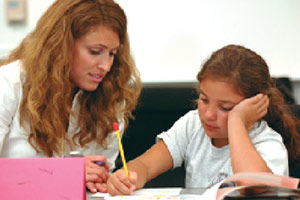Making Connections: The Social Side of Education
 “Many children are just a bad fit for the institutional education we have,” said Cozolino.
“Does that mean they aren’t intelligent? No, it just means their way of learning did
not work with a one-size-fits-all institution.”
“Many children are just a bad fit for the institutional education we have,” said Cozolino.
“Does that mean they aren’t intelligent? No, it just means their way of learning did
not work with a one-size-fits-all institution.”
In his book, Cozolino explores the connection between the brain and human relationships and the implications on student learning. In particular, he emphasizes its importance for students from dysfunctional home environments and dangerous communities, as well as for those who learn in seemingly unconventional ways.
“If children are being abused or neglected at home, their level of stress is generally going to be higher,” Cozolino said. “Not only will they not have the support they need at home to facilitate learning, but the stress and insecurity about their relationships at home actually handicaps their brains’ ability to learn.”
When students’ stress levels are low, the neural systems dedicated to learning enable them to pay attention, learn, and remember. These systems shut down when students are experiencing high levels of stress. A child’s ability to connect positively with a parent in their early years (secure attachment) also plays a critical role.
“Learning and stress are intimately connected,” Cozolino said. “When children are able to form secure attachments to parents and teachers, it enhances enthusiasm for learning, positive memory, and deregulates the stress that can impair learning.”
Cozolino explained that in the brain of a child with insecure attachments, feelings of shame can develop due to the child’s perception that they lack value or the ability to be loved. He said that the shame that comes from abuse or neglect has a lifetime effect on how the children view their ability to learn, their aspirations, or their belief in their ability to succeed.
“For students already dealing with feelings of shame, a school test is inevitably a negative experience because they won’t do perfectly and will feel more ashamed at their perceived shortcomings,” said Cozolino. “For a secure student, a test can be a challenge or an opportunity to prove themselves or make their teacher happy.”
So how are teachers supposed to manage students facing varying levels of stress? Cozolino recommends a move from training teachers in the principles of classroom management, which generally focuses on discipline, to instead focusing on developing skills in classroom leadership.
“There needs to be a shift from information dissemination and control to creating a synergistic, interactive environment where the students are a team, or tribe, working towards a common goal,” Cozolino said. “What makes students successful is their ability to know how to work and love, and teachers are not taught to focus on that aspect of education.”
Click here to read the full article.